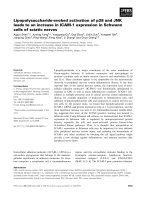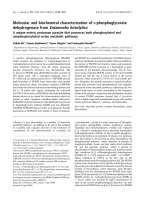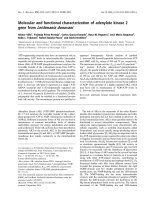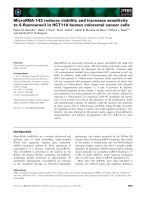MOLECULAR AND CELLULAR MECHANISMS LEADING TO SIMILAR PHENOTYPES IN DOWN AND FETAL ALCOHOL SYNDROMES
Bạn đang xem bản rút gọn của tài liệu. Xem và tải ngay bản đầy đủ của tài liệu tại đây (2.25 MB, 80 trang )
Graduate School ETD Form 9
(Revised 12/07)
PURDUE UNIVERSITY
GRADUATE SCHOOL
Thesis/Dissertation Acceptance
This is to certify that the thesis/dissertation prepared
By
Entitled
For the degree of
Is approved by the final examining committee:
Chair
To the best of my knowledge and as understood by the student in the Research Integrity and
Copyright Disclaimer (Graduate School Form 20), this thesis/dissertation adheres to the provisions of
Purdue University’s “Policy on Integrity in Research” and the use of copyrighted material.
Approved by Major Professor(s): ____________________________________
____________________________________
Approved by:
Head of the Graduate Program Date
Jeffrey Peter Solzak
Molecular and Cellular Mechanisms Leading to Similar Phenotypes in Down and Fetal Alcohol
Syndromes
Master of Science
Randall J. Roper
James A. Marrs
Andrew R. Kusmierczyk
Randall J. Roper
Simon Atkinson
05/22/2012
Graduate School Form 20
(Revised 9/10)
PURDUE UNIVERSITY
GRADUATE SCHOOL
Research Integrity and Copyright Disclaimer
Title of Thesis/Dissertation:
For the degree of
Choose your degree
I certify that in the preparation of this thesis, I have observed the provisions of Purdue University
Executive Memorandum No. C-22, September 6, 1991, Policy on Integrity in Research.*
Further, I certify that this work is free of plagiarism and all materials appearing in this
thesis/dissertation have been properly quoted and attributed.
I certify that all copyrighted material incorporated into this thesis/dissertation is in compliance with the
United States’ copyright law and that I have received written permission from the copyright owners for
my use of their work, which is beyond the scope of the law. I agree to indemnify and save harmless
Purdue University from any and all claims that may be asserted or that may arise from any copyright
violation.
______________________________________
Printed Name and Signature of Candidate
______________________________________
Date (month/day/year)
*Located at />Molecular and Cellular Mechanisms Leading to Similar Phenotypes in Down and Fetal Alcohol
Syndromes
Master of Science
Jeffrey Peter Solzak
05/22/2012
MOLECULAR AND CELLULAR MECHANISMS LEADING TO SIMILAR
PHENOTYPES IN DOWN AND FETAL ALCOHOL SYNDROMES
A Thesis
Submitted to the Faculty
of
Purdue University
by
Jeffrey Peter Solzak
In Partial Fulfillment of the
Requirements for the Degree
of
Master of Science
August 2012
Purdue University
Indianapolis, Indiana
ii
For my wife.
iii
ACKNOWLEDGMENTS
I would like to thank my family for the enormous amount of support they
have given over the years. Without you I would have never been able to do this.
I would also like to thank my advisor Randall Roper not only for his teaching
capabilities, but for his ability to keep me sane and always being able to put
things into perspective.
As for my fellow graduate lab mates, without the two of you this whole
experience would have been nowhere near as much fun. Thank you for the
laughs on a daily basis!
iv
TABLE OF CONTENTS
Page
LIST OF TABLES vi
LIST OF FIGURES vii
ABSTRACT………………………………… viii
CHAPTER 1: INTRODUCTION 1
1.1 Introduction to Down Syndrome and Fetal Alcohol Syndrome 1
1.2 Mouse models of DS and FAS 3
1.3 Phenotypes of DS and FAS 4
1.3.1 Morphogenic Traits 4
1.3.2 Implications of Neural Crest in Development 5
1.3.3 Genetic Expression of Cardinal Genes 6
1.3.4 Occurrence of Apoptosis 8
1.3.5 Expression of Activated Akt in DS and FAS 9
1.4 Immunodeficiency in Down syndrome 11
1.4.1 Proteasomes and immunodeficiency 12
1.5 Hypotheses 13
1.5.1 Similarities in DS and FAS 13
1.5.2 pAkt in DS and FAS 14
1.5.3 Proteasome assembly in Ts65Dn 15
CHAPTER 2: MATERIALS AND METHODS 16
2.1 Breeding of mouse model embryos of DS and FAS 16
2.2 Polymerase Chain Reaction (PCR) Genotyping 17
2.3 Fluorescence In Situ Hybridization (FISH) Genotyping 18
2.5 MicroCT 21
2.6 Immunohistochemistry 22
2.7 Protein Homogenization from adult tissue 23
2.8 BCA protein concentration assay 24
2.9 Polyacrylamide Gel Electrophoresis 25
2.10 Western Blot 26
2.11 Cryostat embedding and sectioning 27
v
Page
2.12 Immunofluorescence 28
2.13 Immunofluorescence Analysis 29
CHAPTER 3: RESULTS 31
3.1 Craniofacial analysis of DS and FAS 31
3.2 Altered Dyrk1a and Rcan1 expression in DS and FAS embryos 32
3.3 Analysis of apoptosis using c-Caspase 3 in the BA1 and the brain 34
3.4 Increased expression of Ttc3 causes a decrease in pAkt 35
3.5 β5t and β6 protein levels in Ts65Dn thymus 36
CHAPTER 4: DISCUSSION 37
4.1 DS and FAS Craniofacial Analysis 37
4.2 Cardinal Genes Dyrk1a and Rcan1 38
4.3 Occurrence of Apoptosis in DS and FAS 40
4.4 pAkt expression in Ts65Dn 42
4.5 Immunodeficiency in DS 43
REFERENCES.………………………………………………………………….…….45
TABLES…………………………………………………………………………………56
FIGURES……… 59
vi
LIST OF TABLES
Table Page
Table 1 Phenotypic Analysis of DS and FAS 54
Table 2 Dyrk1a and Rcan1 Expression 55
Table 3 c-Caspase Expression 56
vii
LIST OF FIGURES
Figure Page
Figure 1 MicroCT analysis 57
Figure 2 Dyrk1a Expression in DS and FAS Mouse Models 58
Figure 3 Rcan1 Expression in DS and FAS Mouse Models 59
Figure 4 Immunohistochemistry analysis using Caspase 3 60
Figure 5 Ttc3 Expression in Ts65Dn 61
Figure 6 40X immunofluorescence of pAkt in the BA1 of Ts65Dn 62
Figure 7 80x Immunofluorescence of pAkt in the BA1 in Ts65Dn 63
Figure 8 Immunofluorescence Analysis of pAkt expression in the nucleus 64
Figure 9 Proteasome Subunit Analysis on Ts65Dn Thymic Tissue 65
viii
ABSTRACT
Solzak, Jeffrey Peter, M.S., Purdue University, August 2012. Molecular and
Cellular Mechanisms Leading to Similar Phenotypes in Down and Fetal Alcohol
Syndromes. Major Professor: Randall J. Roper.
Down syndrome (DS) and Fetal Alcohol Syndrome (FAS) are two leading
causes of birth defects with phenotypes ranging from cognitive impairment to
craniofacial abnormalities. While DS originates from the trisomy of human
chromosome 21 and FAS from prenatal alcohol consumption, many of the
defining characteristics for these two disorders are stunningly similar. A survey of
the literature revealed over 20 similar craniofacial and structural deficits in both
human and mouse models of DS and FAS. We hypothesized that the similar
phenotypes observed are caused by disruptions in common molecular or cellular
pathways during development. To test our hypothesis, we examined
morphometric, genetic, and cellular phenotypes during development of our DS
and FAS mouse models at embryonic days 9.5-10.5. Our preliminary evidence
indicates that during early development, dysregulation of Dyrk1a and Rcan1,
cardinal genes affecting craniofacial and neurological precursors of DS, are also
dysregulated in embryonic FAS models. Furthermore, Caspase 3 was also found
to have similar expression in DS and FAS craniofacial neural crest derived
ix
tissues such as the first branchial arch (BA1) and regions of the brain. This may
explain a developmental deficit by means of apoptosis. We have also
investigated the expression of pAkt, a protein shown to be affected in FAS
models, in cells located within the craniofacial precursor of Ts65Dn. Recent
research shows that Ttc3, a gene that is triplicated and shown to be
overexpressed in the BA1 and neural tube of Ts65Dn, targets pAkt in the nucleus
affecting important transcription factors regulating cell cycle and cell survival.
While Akt has been shown to play a role in neuronal development, we
hypothesize that it also affects similar cellular properties in craniofacial
precursors during development. By comparing common genotypes and
phenotypes of DS and FAS we may provide common mechanisms to target for
potential treatments of both disorders.
One of the least understood phenotypes of DS is their deficient immune
system. Many individuals with DS have varying serious illnesses ranging from
coeliac disease to respiratory infections that are a direct result of this
immunodeficiency. Proteasomes are an integral part of a competent and efficient
immune system. It has been observed that mice lacking immunoproteasomes
present deficiencies in providing MHC class I peptides, proteins essential in
identifying infections. A gene, Psmg1 (Dscr2), triplicated in both humans and in
Ts65Dn mice, is known to act as a proteasome assembly chaperone for the 20S
proteasome. We hypothesized that a dysregulation in this gene promotes a
proteasome assembly aberration, impacting the efficiency of the DS immune
x
system. To test this hypothesis we performed western blot analysis on specific
precursor and processed β-subunits of the 20S proteasome in thymic tissue of
adult Ts65Dn. While the β-subunits tested displayed no significant differences
between trisomic and euploid mice we have provided further insight to the origins
of immunodeficiency in DS.
1
CHAPTER 1: INTRODUCTION
1.1 Introduction to Down Syndrome and Fetal Alcohol Syndrome
Down syndrome (DS) is the most common genetic disorder that affects
approximately 1 out of 750 live births mostly occurring from three copies of
chromosome 21 (Hsa21). This chromosomal aberration was first described by
Jerome Lejeune in 1959 while conducting research in attempts to cure DS;
however many of the distinct phenotypes associated with DS were first defined
by John Langdon Down in 1866. DS can occur several different ways with the
vast majority (~95%) caused by non-disjunction resulting in a true trisomy
(HASSOLD and SHERMAN 2000). Approximately 5% of all other DS cases are
caused by Robertsonian translocations, mosaicicm, or partial trisomy of Hsa21.
Robertsonian translocations in DS are a result of a hybrid chromosome
containing the long arm of Hsa21 and usually the long arm of Hsa14 (BEREND et
al. 2003). Mosaicisim, the rarest of DS occurrences, is where only a portion of
the cells contain a true trisomic nature. These individuals have a tendency to
have less severe phenotypes associated with DS and many times go unnoticed.
DS has been defined by over 80 distinct phenotypes that affect
craniofacial characteristics, heart, central nervous system, immune system, and
2
skeletal structure (BLAZEK et al. 2011; EPSTEIN 2001; RICHTSMEIER et al. 2000;
VAN CLEVE and COHEN 2006). Characteristics developing later in life may include
immunodeficiency, early onset Alzheimer disease, and celiac disease (EPSTEIN
2001; RAM and CHINEN 2011). Many of these traits however vary widely from
individual to individual (WISEMAN et al. 2009). Even though the genetic nature of
DS has been identified, the mechanisms and pathways that influence these
phenotypes are still largely unknown.
Fetal alcohol syndrome (FAS) is a disorder that is caused by the
consumption of alcohol by the expectant mother. It affects approximately 1 out of
1000 live births (ABEL and HANNIGAN 1995). This particular disorder has been
observed for centuries but it was not until 1973 that two Seattle physicians fully
described and brought attention to FAS (JONES and SMITH 1973). Since their
publication, concern for FAS has become much more abundant going as far as
charging a woman who drank during her pregnancy with felony child abuse in
1991(ARMSTRONG and ABEL 2000).
Many individuals that have FAS present variations of phenotypes as well
as severity. This may be due to genetic variation as well as quantity and length of
exposure to ethanol during development (ANTHONY et al. 2010a; CHEN et al.
2011). Many of these phenotypes are much like those found in DS and include
craniofacial deficits, abnormalities in neurogenesis, and other structural
anomalies (ANTHONY et al. 2010a; GRESSENS et al. 1992; RILEY et al. 2011).
Because of the wide range and variation of phenotypes, it is difficult to diagnose
3
FAS early in life (SCHAEFER and DEERE 2011). These phenotypes arise in
development and do not progress in adults. However, due to the damage already
done, many individuals with FAS face many behavioral problems and cognitive
impairment throughout their lives (FOLTRAN et al. 2011; JACOBSON et al. 2011;
WYPER and RASMUSSEN 2011).
1.2 Mouse models of DS and FAS
Many investigators of DS and FAS use mouse models to emulate traits of
these disorders found in humans. While there are several types of mice
exhibiting DS like phenotypes, the Ts65Dn mouse model has been most often
used with great success. The genes on Hsa21 are mostly conserved in mice;
however these genes are separated across three different chromosomes, 10, 16,
and 17. Chromosome 16 (Mmu16) in mice contains many of the significant
genes, as well as the majority of the DS orthologues found in humans. Ts65Dn
contains a trisomic segment of Mmu16 which accounts for approximately half of
the gene orthologues that are triplicated in human DS (GARDINER et al. 2003).
The aneuploidy of this mouse causes similar phenotypes as seen in humans
such as reduced mandible and maxillary regions, rostro-caudal dimensions of the
neurocranium, and overall reduction and flattening of the face (RICHTSMEIER et al.
2000).
FAS investigators have several mouse model resources to study. It has
been observed that embryos from different genetic backgrounds vary in
4
susceptibility to ethanol consumption while also presenting different resultant
phenotypes. For this reason, the mouse strain C57BL/6 is the top choice
because of its willingness to consume ethanol and the craniofacial features
created are the closest to traits found in human FAS (ANTHONY et al. 2010a;
KHISTI et al. 2006; OGAWA et al. 2005; SULIK 2005). Investigators also use a
culturing method when studying development. Instead of feeding the mother
ethanol, the embryos are extracted at a specific time point and placed in an
ethanol solution. While culturing embryos may cause differences of expression in
specific genes, it is an invaluable way to control the developmental age and
amount of ethanol the embryo receives (CHEN et al. 2011).
1.3 Phenotypes of DS and FAS
1.3.1 Morphogenic Traits
Anthropometry is the science of measuring the size, weight, or proportions
of an organism’s body. It has been largely used to compare the differences in
humans with DS and FAS to normal individuals as well as the mouse models for
these respective syndromes (ANTHONY et al. 2010a; RICHTSMEIER et al. 2000;
RICHTSMEIER and DELEON 2009). Many of these measurements have focused on
their defining craniofacial abnormalities. Through measurements using DS and
FAS models, investigators found many specific deficits in facial height, width, and
depth, as well as smaller orbital regions, nasal length, and ear distances
5
(ALLANSON et al. 1993; ANTHONY et al. 2010a; MOORE et al. 2002; MOORE et al.
2007; RICHTSMEIER et al. 2000). Other measurements have concentrated on
regions of the brain in which deficits have been observed. Areas such as the
hippocampus, cerebellum, and cortex have been shown to be significantly below
normal size in both syndromes (CEBOLLA et al. 2009; FIDLER and NADEL 2007;
LOMOIO et al. 2009; NORMAN et al. 2009; SERVAIS et al. 2007). Using these
measurements, regions of interest have been elucidated for molecular and
cellular research.
1.3.2 Implications of Neural Crest in Development
The neural crest (NC) is a multipotent stem cell population that emerges
and migrates from the neural folds to produce many important tissues throughout
development. Once they arrive to their destination, NC can differentiate into a
number of different cells. The more specific cranial neural crest (CNC) have the
potential to differentiate into cells of the nervous system, bone, and connective
tissue (SANTAGATI and RIJLI 2003). The CNC makes up the vast majority of the
cell population in the first branchial arch (BA1), a region which gives rise to the
mid and lower face including the mandible. For this reason, the BA1 is largely
investigated in craniofacial diseases such as DS and FAS. In addition to the
mandible, other NC derived structures display deficits as well, including the heart
and GI tract (AWAN et al. 2004b; BURD et al. 2007; HOFER and BURD 2009;
WEIJERMAN et al. 2010). Ts65Dn mice display NC deficits resulting in craniofacial
6
and neurological abnormalities (ROPER et al. 2009). This NC deficit may be
caused by the dysfunction of several integral genes that can be tied to the
trisomic nature of DS. In FAS, tissues contain deficits caused by an early and an
above normal occurrence of apoptosis where large amounts of NC reside (WANG
and BIEBERICH 2010).
1.3.3 Genetic Expression of Cardinal Genes
Of the approximately 300 genes that are triplicated in DS, there are
several that have been studied extensively. Dyrk1a is a serine-threonine kinase
that is found on Hsa21 and is triplicated in most of the major DS mouse models
including Ts65Dn. It is an important kinase that regulates many downstream
proteins and transcription factors. Some of these transcription factors include
cyclic AMP response element-binding protein (CREB), forkhead in
rhabdomyosarcoma (FKHR), and nuclear factor of activated T cells (NFAT)
(ARRON et al. 2006; BRANCHI et al. 2004). Dyrk1a dysregulation affects many
functions such as proliferation, differentiation, and cell survival (YABUT et al.
2010). Because of the multiple roles regulated by Dyrk1a, it has been implicated
in many traits of which neurodegenerative diseases are the most studied (JONES
et al. 2012; WEGIEL et al. 2011a). Dyrk1a has been shown to have a role in
Alzheimer disease (AD), seen early in DS individuals, by hyperphosphorylating
tau causing impaired microtubule assembly and neurofibrillary degeneration
(RYOO et al. 2008; WEGIEL et al. 2011b). The phosphorylation of APP by an
7
overexpressed Dyrk1a is also thought to be a main cause of the pathogenesis of
AD (RYOO et al. 2008). DS individuals have also presented amyloid senile
plaques associated with AD symptoms (PARK et al. 2009a). The associated
mechanism is an interaction between beta-amyloid precursor protein (APP) and
Dyrk1a (PARK et al. 2007). With APP’s location on Hsa21, the expression levels
are increased allowing this to occur.
Regulator of calcineurin 1 (Rcan1 or Dscr1) is another gene that has been
implicated in several phenotypes in DS. This is done through the increase of
Rcan1 and its inhibition of calcineurin, a calcium activated serine/threonine
protein phosphatase (FUENTES et al. 2000). When calcineurin is inhibited,
proteins and transcription factors are not dephosphorylated affecting their
activity. Rcan1 plays several roles and is expressed in many tissues in
development including the central nervous system. In adults, Rcan1 has been
shown to be expressed in several tissues such as the heart, liver, and many
important regions of the brain including the cerebral cortex and hippocampus
(ERMAK et al. 2001). It has been implicated in the development of Alzheimer
disease by inhibiting the dephosphorylation of tau (LLORET et al. 2011). Rcan1
has also been known to play roles in cardiac and skeletal muscle hypertrophy as
well as immunodeficiency through its interaction with Nfat (HARRIS et al. 2005;
RAM and CHINEN 2011).
Dyrk1a and Rcan1 have significant interactions with Nfat, an important
transcription factor hypothesized to be involved in DS. With a theoretical
8
increased dosage, both Dyrk1a and Rcan1 may play an inhibitory role on Nfat
keeping it from localizing in the nucleus (EPSTEIN 2006). Nfat has been linked to
bone development with a role in osteoblast and osteoclast differentiation and
homeostasis (ASAGIRI et al. 2005; FROMIGUE et al. 2010; LEE et al. 2009). It also
has been investigated as a potential mediator of apoptosis during development,
being integral in neurogenesis, and a potential cause of craniofacial
abnormalities, cognitive impairment, and motor function (ARRON et al. 2006;
SRIVASTAVA et al. 1999).
1.3.4 Occurrence of Apoptosis
Apoptosis has been a common theme in investigating developmental
deficits in individuals with DS and FAS. Although actual mechanisms are still
under debate, it has been shown that there is nearly a five-fold increase in
apoptosis in the BA1 of embryos treated with ethanol (WANG and BIEBERICH
2010). More specific investigation shows that in developing embryos of several
different FAS models, ethanol causes high levels of apoptosis in NC (FLENTKE et
al. 2011; GARIC-STANKOVIC et al. 2005; WANG and BIEBERICH 2010). Other studies
show that an epigenetic mechanism, like methylation, may have an effect on pro
apoptotic genes in FAS models (LIU et al. 2009). Apoptosis has also been
studied in DS, however unlike FAS, adult models have had more of a focus. It
has been shown that there is a common occurrence of early onset Alzheimer
disease accompanied by apoptosis in regions of the brain in individuals with DS
9
(LU et al. 2011). Recent studies confirm an overabundance of apoptosis located
in the cerebellum that may be caused by trisomic genes such as Rcan1 (SUN et
al. 2011). Ets2, a gene triplicated in DS, has also been shown to be induced by
oxidative stress and has the potential to cause overstimulated proapoptotic
pathways in both DS and Alzheimer (HELGUERA et al. 2005).Currently there have
been studies focusing on apoptosis in DS neural development as well. A recent
study found that an increase of S100B, a trisomic gene, may result in apoptosis
and oxidative stress in human neural progenitors (LU et al. 2011). There have
been no investigations to study the possible expression or effects of high
occurrence of apoptosis in craniofacial precursors and a possible cause of
distinct DS phenotypes.
1.3.5 Expression of Activated Akt in DS and FAS
Understanding the mechanisms behind the craniofacial and neurological
deficits of DS remains integral in current research. While Dyrk1a and Rcan1 have
been implicated in both facial and neuronal traits, there are many other genes
such as Ets2, Olig1, and Olig2 that are suspected as well (CHAKRABARTI et al.
2010; HELGUERA et al. 2005; LU et al. 2011). While several genes may play an
essential role in the development of these traits, little is known about how much
of a role each one has and the underlying pathways involved.
In recent studies, a novel gene that is triplicated in both Ts65Dn and
humans with DS that affects neurogenesis when it is expressed at increased
10
levels has been identified (BERTO et al. 2007). This gene, Ttc3, is an E3 ligase
that targets Akt for ubiquitination when it is activated (SUIZU et al. 2009). Akt is a
serine/threonine kinase that is responsible for many processes including cell
proliferation, cell migration, cell survival, and differentiation (ENOMOTO et al. 2005;
PENG et al. 2003; SHIOJIMA and WALSH 2002; SUIZU et al. 2009; WANG and
BRATTAIN 2006). It does this by its ability to act on specific transcription factors
such as CREB and NF-κB (PATRA et al. 2004; WANG and BRATTAIN 2006). For
these reasons, it has been highly investigated in several types of cancer as a
potential for pharmacotherapy. It has also been observed as a crucial gene in
Proteus syndrome, a genetic disorder in which a hyperactive PI3K-Akt pathway
causes abnormal bone calcification, overgrowth of skin, brain, connective tissue,
and tumor susceptibility (LINDHURST et al. 2011). Another protein Akt regulates is
p300, a transcriptional coactivatior. When Akt is activated via phosphorylation
and is localized in the nucleus, it binds to p300 which then increases histone
acetyl transferase activity (HAT) (HUANG and CHEN 2005). With HAT activity
increased, transcription factors are able to access DNA that was previously
blocked. This also opens DNA access for other proteins such as polymerases to
induce transcription.
While pAkt and Ttc3 have been observed to be dysregulated in DS in vitro
models, a recent genomic analysis of FAS has shown that Akt is downregulated
(HARD et al. 2005). Unlike DS, individuals with FAS have decreased inactive form
of Akt due to an increase in PTEN, a protein responsible for the inhibition of the
11
PI3K-Akt cascade (GREEN et al. 2007; XU et al. 2003). With Akt being profoundly
involved in cell survival and the signaling pathway of apoptosis, it is reasonable
to assume that apoptosis found in FAS models may be caused by a deficiency of
Akt in the BA1.
1.4 Immunodeficiency in Down syndrome
Individuals with DS have been shown for over 30 years to have a
decreased functional immune system (BURGIO et al. 1978). There are many traits
that have been investigated in DS, however, immunodeficiency is one of the least
understood. Diseases such as acute lymphoblastic leukemia, hypothyroidism,
and coeliac disease are major problems in individuals with DS (BIRGER and
IZRAELI 2012; GEORGE et al. 1996; SELIKOWITZ 1993). Two of the more abundant
problems are respiratory and ear infections. Many of these infections may be
caused by morphological traits such as abnormal inner ear canal and
tracheomalacia (RAM and CHINEN 2011). While these are thought to be
secondary, much of the initial problem lies in the mechanisms that control the
immune system. Many of these mechanisms including proteasomal activity,
which plays a major role in the immune system, may be regulated by genes that
are triplicated in DS.
12
1.4.1 Proteasomes and immunodeficiency
The 26S eukaryotic proteasome is made up of two sections, a catalytic
20S proteasome and a 19S regulatory particle (SASAKI et al. 2010). The 20S
proteasome is made up of numerous α and β subunits creating a cylindrical
structure. While many recent studies have focused on how this structure is
assembled, it is known that there are proteins responsible for helping assemble
the proteasomes. One of these helper proteins is called the proteasome
assembly chaperone 1 (PAC1). Its responsibility lies in the accurate assembly of
the 20S proteasome and in particular dealing with the α subunits. This process
using PAC 1 has been shown to be essential in specific tissues of the developing
mouse including the brain (SASAKI et al. 2010).
Proteasomes are an integral part in sustaining the immune system. They
play an important role of removing invading proteins from the cell and slicing
them up into pieces via the ubiquitin system. These pieces are then used in
creating the peptides used in MHC class I molecule binding. This is the basis for
the vertebrate adaptive immunity (KASAHARA et al. 2004). There are two major
categories of proteasomes, the standard proteasome and the
immunoproteasome. The immunoproteasome is the one thought to be specific to
create these MHC class I binding peptides (MURATA et al. 2008). Within the
immunoproteasome category, a more specific proteasome named the
thymoproteasome has been discovered recently.
13
The thymoproteasome is distinct in that the β5 subunit is different from
the standard and immunoproteasome. The β5t, the “t” standing for thymus,
contains a different configuration in which contains a distinct make-up different
than β5i and β5 (FLOREA et al. 2010). This difference in composition creates a
different peptidase activity compared to other β5 subunits. This type of activity
can be characterized by the amino acids present in the S1 pocket of the β5
subunit. Compared to the other two known β5 subunits, β5t contains more
hydrophilic residues creating a weaker chymotrypsin-like peptidase activity
(MURATA et al. 2007). This weaker chymotrypsin-like activity presents a decrease
in the Michaelis constant values, however, the overall activity of the proteasome
was not changed. It is thought that this difference on protein degrading activity
caused by β5t gives rise to specialized peptides, utilized in positive selection of
CD8+ T cells (MURATA et al. 2008).
1.5 Hypotheses
1.5.1 Similarities in DS and FAS
Individuals with DS and FAS have been observed to present similar
morphological phenotypes. For this reason we hypothesize that the Ts65Dn
mouse model of DS exhibits analogous craniofacial phenotypes to an FAS
mouse model and these phenotypes arise from similar molecular and cellular
origin. We examined craniofacial characteristics of our DS and FAS mouse









